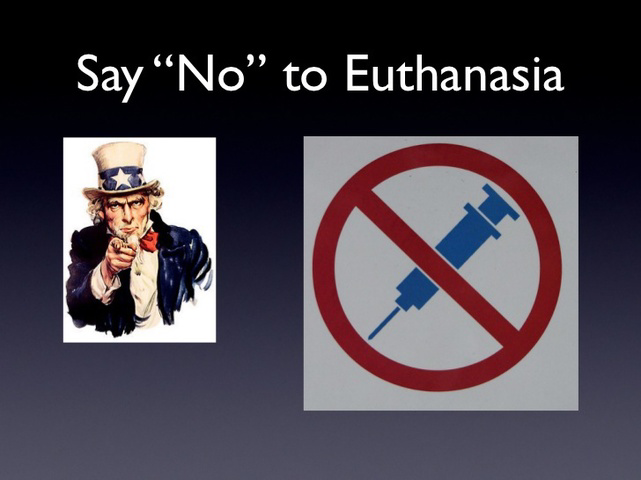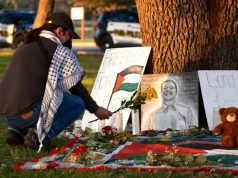Euthanasia is derived from the Greek word – Euthanatos, literally meaning ‘good death’. It refers to the intentionally terminating life to end pain and sufferings usually from incurable disease and terminal condition.
The actively and deliberately killing of the terminally ill patient with his/her consent, by introducing lethal dose of injections, like those of morphine and barbiturates, is termed Active Euthanasia, i.e. physician assisted suicide. While the passive euthanasia is letting the patient die by withdrawing or withholding the treatment. There is a practice of ‘Do not attempt cardiopulmonary resuscitate’ (DNACPR) order, where persons request not to receive treatment if their heart stops or they stop breathing, or switching off the life support system, this is passive euthanasia, as a person is denied treatment that could potentially save his life.
When a patient requests for physician assisted suicide in voluntary euthanasia, it is actually a cry for help out of depression and distress, from pressure of feeling a burden, which can be controlled by good symptom control, counselling, assistance and the alternatives as solution for the real problems. A person who wants to kill himself doesn’t need legalised assisted suicide but a doctor better trained in alleviating pain. People who support voluntary euthanasia also favour non-voluntary euthanasia in case of mentally retarted, unconscious terminally ill patients and very young kids, as they think that their lives are not worth living and are useless resources. But opponents say, “This is the voluntary murder of a human being who cannot speak for himself – the voluntary murder of a human being who cannot express what he is thinking.” A doctor’s role is to help and save lives, not end them. Casting physicians in the role of administering euthanasia would undermine and compromise the objectives of the medical profession.
In the framework of The Hippocratic Oath, which dates back from 4th century B.C, and the modern Declaration of Geneva adopted by 2nd general assembly of the World Medical Association (WMA) in 1948, conveys the strong commitment to ethical behaviour in medical professional practice, and recognizes Non-maleficence and beneficence among the basics of the medical ethics. This is the principle of “No harm No harassment”. It lays down the justificatory force of the ruling to avoid causing harm and harassment to the patient. Legalising euthanasia violates this most important ruling “A physician shall bear in mind the obligation to respect human life.”
Palliative treatment is a much better alternative in terminally ills which primarily intend to relieve pain and suffering not to kill the patient but the patient’s death may be possible side effect of the treatment. This is known as “Doctrine of Double Effect”. The goal is to achieve comfort at the lowest dose of sedative possible and at the lightest level of sedation; and not hastening death which differentiates it from euthanasia. With proper palliative care, strategies to improve the sense of dignity and hope have been shown to work in the areas of stress and burden.
Physicians may feel pressured to argue to a patient’s wish for euthanasia even when they know they can alleviate their pain. Moreover, it will discourage the search for effective cure and treatments for terminally ill.
Slippery Slope Argument
This is based on the concern that legalising euthanasia could lead to significant unintended changes in the health care system and society at large, it is feared that it later come to regret. For instance, when the legislation for abortion was passed in 1968, it was never expected that it could exceed to the extent every year that now it is available on demand. Similarly there has been a slippery slope about the legislation of justified killing. Humans have inclination to go beyond any set limits. It can lead to a climate where euthanasia becomes not just permissible but desirable. Legalising this will corrupt the doctor-patient relationship. Doctor prescribes medicine out of desire to save lives and relieve sufferings, not to have to kill their patient. Physicians may feel pressured to argue to a patient’s wish for euthanasia even when they know they can alleviate their pain. Moreover, it will discourage the search for effective cure and treatments for terminally ill.
Netherland is one of the few countries which has waved green flag for voluntary euthanasia. CMDS Executive Director Dr. David Stevens explains “assisted suicide cannot be controlled or regulated, no matter how many safeguards are built in to protect patients from involuntary euthanasia. The data speaks for itself: one in five cases of assisted suicide occurred in Holland without the patient’s consent and in 17% cases, other treatment options were available. Almost two-third of the euthanasia cases in 1995 were not reported. With this kind of irresponsibility and neglect, who will even know that what really went between a doctor and a patient when patient is dead?”
Defining Death
Death is the most certain and biggest truth of human’s life, which is often perceived as an obstacle to the enjoyment of expanding material pleasures of the world; and an evil to be subjugated through biomedical research and technology. New techniques like life supporting system, mechanical respirators, pulse controllers, etc. have rendered the task of defining death the most pressing issue in the field of biomedical ethics
The traditional view about the death- the separation of spirit from the body is not susceptible of empirical verification. With development in medical technologies even the failure of cardiac and respiratory function is no longer the valid indicator of death. The definition established by the Ad HoC Committee of the Harvard Medical School, considers a patient is dead if the irreversible coma or a chronic vegetative state suffered because of disease or accident, the higher cortical functioning of the brain is permanently damaged. If this definition gains acceptance then the patient would be considered dead if the cortex is non-functional, even though the lower brain function persists meaning that the individual is not completely brain dead. Some thinks that total loss of electrical activity of brain, neglecting brain stem, amounts to death. The issue becomes more complex when the comatose individual is a potential source of organ transplant. If that individual remains alive by any reasonable definition, then switching off his life supporting system and harvesting organ would be stated as inhuman act of Man Slaughter.
Unstable life is the existence of intermediate state between life and death showing lingering life but not consistent cardiac and pulmonary function, as in the case of comatose patients. It is said to be the state when the soul has not completely departed from the patient’s body. The person cannot be regarded dead until the spirit completely left the body. Loss of personhood also defines death, i.e. loss of personal identity, reasoning, remembering, feeling emotional, interacting with others and so on. This criterion concerns more about individual’s function than about his/her brain.
Developing health care technology is a factor fuelling support for euthanasia. “Having created the situation in which lives are constantly saved, transformed or prolonged by medical interventions, we can hardly pretend the process of dying, and that alone, must be left to nature.” (VES)
Sanctity of Life
Theologically, all human life is sacred because it is given by Almighty and He chooses how long each person will live. Human beings must not interfere in this. Euthanasia violates this notion of life. Islam and Christianity strictly forbid euthanasia. No such ruling about euthanasia is there in Hinduism and Buddhism but their jurists agree on banning of mercy killing.
Quran says,
“Do not kill yourselves, for verily Allah has been to you most merciful” (4:29)
“…take not life which Allah has made sacred” (6:151)
“and (Allah) is the one who gave you life, then shall He ordain you to die, than shall He give you your life again, truly mankind is ungrateful.” (22:66)
Islam encourages believers to remember and prepare for death but yet it is forbidden to wish for death as it emphasizes death as an inescapable phenomenon on which only Almighty has the power to conquer it.
Everyone has the right to life, consequently there is no existence like right to die; all human beings are to be valued, irrespective of age, sex, religion, social status or their potential for achievement. Considering some lives (sick, disabled or elderly) as unworthy and burden on society is directly murdering humanity. Support caring, not killing.






